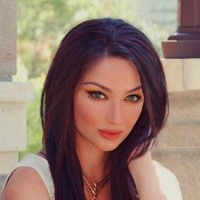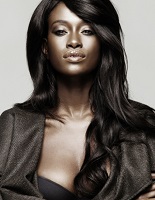EBiology
Physical AppearanceEypharians age much like humans, but have a complexion that allows them to age more gracefully than many. This longevity of looks may also be attributed to their consummate vanity that encourages the use of creams, oils and makeup to protect them from sun exposure.
Eypharian skin tone ranges from tan to olive and appears faintly gilded in high light. Paler or darker skin tones are possible due to heritage, but are uncommon. Natural hair colors tend to be blacks and browns but many, particularly women, dye their hair vivid colors. Eye color ranges widely within normal colors, though paler tints are uncommon.
Arms [insert bone structure image]
The most noticeable feature of any Eypharian is the number of arms. Due to the bone structures, the shoulders and chest of an Eypharian appear to be slightly wider than an average humanoid but are in fact only an average of two to four inches wider.
The arrangement of the shoulders, and thus the arms, is primarily vertical and then horizontally staggered, allowing each of the arms to rest only partially on top of one another:
- The top shoulder is centered and slightly extended outwards from the body, and is roughly where the shoulders are in two-armed beings. It is this shoulder that visually defines the breadth of the shoulders, and the positioning is the same for 4- and 6- armed Eypharians.
- The middle shoulder is set down and slightly forward, meaning the back edge is an inch or two underneath the top shoulder. In 4-armed Eypharians, this shoulder joint is missing, resulting in the lowest shoulder developing further up and very slightly forward.
- The lowest shoulder is the one set furthest back, the front edge an inch or two under the back edge of the top shoulder. In 6-armed Eypharians, these arms have difficulty moving forward unless the other arms are also extended outward. In 4-armed Eypharians, these arms are not set quite as far back, making them rest more underneath the top shoulder and consequently much more dexterous.
PheromonesAnother feature unique to the Eypharians are glands on either side of the base of the neck that excrete pleasant smelling pheromones. These glands emerged as an unnoticed mutation in the Eypharian race some generations after Royet’s emergence, but there is no evidence it was studied or even noticed.
Physically, the glands produce a small amount of what can appear to be sweat at the base of the neck. On the surface of the skin, the small glands on either side of the neck are invisible, though with pressure applied to the area, it is possible to feel the sacs nestled under the skin just above the clavicle. Each gland is the size of a large peanut and feels soft and malleable. During high pheromone production, the skin of the neck may feel moist, but it is difficult to detect gland activity visually.
On an average day, pheromone production will only result in the Eypharian in question simply smelling pleasant. However, many factors can change pheromone production or their scent. Male pheromones in particular do not smell as strong as females', but is no more or less pleasant. In females, production is at its height during ovulation, to the point where it is as noticeable as strong perfume. This period lasts 3-5 out of every 28 days and is as regular as the women’s menstrual cycle. During pregnancy, female pheromones continue production, but at a lower rate and slightly different in smell, which reverts to normal levels after birth. In males and females, sweat will not increase pheromone production, but existing pheromones will smell stronger, combined with the scent of typical body odor. Immediately after washing, particularly if the glandular area is scrubbed, pheromone production will be low and the scent almost non-existent. During sexual arousal, pheromone production may increase, though how much varies from person to person.
In males and females, pheromones begin secreting at sexual maturity. In females, after the onset of menopause and the end of fertility, pheromone production may continue at a lower rate for 1-3 years before finally tapering off. Male pheromones are produced from maturity until death.
The scent of every man and woman is different, though only those highly experienced in the art of perfumery may be able to detect the subtle differences in similar-smelling pheromones. Scents have a wide range of bases, but all have musky undertones that tie strongly to, and often inspire, sexual attraction. Additionally, an Eypharian’s scent may change slightly throughout their lifetime.
Pheromone harvesting is a trade common in Eypharian perfumers, and a widely sought export. Collection methods vary from master to master, but in most cases, the subject is willing. Piercing the gland is ineffective – even if the harvester is able to successfully target the gland, only a small amount is stored in the small sac at any one time and damaging the gland runs the risk or altering or halting the production of pheromones altogether.
FashionExalted as Eypharian skin is, it is not enough to walk about with it bare. The need for betterment extends from the djed to the skin, and the meanest of Eypharians can scrape together a couple mizas for some method of adorning themselves.
Very elaborate makeup is widespread on women and men even line their eyes in kohl or use mica dust. Caretakers for the elderly and children are expected to be well-versed in cosmetology, to adorn those who cannot do it themselves. It is a common joke Eypharian women are born with such designs on their skin. Hair is often painted and sometimes adorned with fine chains of precious metal. If an Eypharian woman is not in the habit of painting her hair, she will keep it exceptionally long. Either sex wears jewelry as a display of power and rank.
Clothing tends to consist of linen made from flax and is lightweight to combat the desert heat. Silk or exotic animal pelts are worn by the upper classes or those aspiring to such positions. Eypharians love color, especially since the richness of hue indicates the costliness of the clothes. Since true black is exceptionally hard to produce, only nobility may wear it.
Men wear solid color kilts that stop at the end of the thigh, a bandolier and some sort of light armor on their wrists. Women wear sleeveless robes or delicate sheaths of linen bound at the waist with cords or gem encrusted belts. The neck is considered an erogenous zone by Eypharians, especially the glandular area, so women frequently wear collars or paint to highlight the grace of their neck or the curve between it and the shoulder. Footwear is a simple sandal of leather, wealth being shown by the amount of semiprecious stones on its straps. Indoors, the lower class tend to wear slippers made of reeds.
Due to societal emphasis on the caretaking of the body, it is not uncommon for the young and fit to dress in revealing clothing, though there is a fine, often blurry, line between what is revealing and what is revealing too much.
[insert section on genetics]
ReproductionReproduction and gestation for Eypharians is identical to humans, being 9 months long. There can be occasional complications with additional arms, most often with 6-armed babies. Babies of any race born breech, that is, bottom down instead of head down, can be extremely dangerous for the mother and/or child. However, 4- and especially 6-armed babies born this way are doubly dangerous due to the additional width of the arms. Cesarean sections are uncommon due to the danger of such an invasive procedure and only performed as a last resort. Breech babies account for only 4% of births, so while it is a danger and a concern, it is uncommon.
The process of reproduction is one carefully monitored in Eypharian society, meaning all births need to be registered with the Zapatl. To carefully enforce the purity of the Eypharian race, far-traveled Eypharians are strongly encouraged to return to Ahnatep during their lives to reproduce and share the divine djed in their veins. Any who refuse to return would not be dragged back in chains, but shame would be brought upon themselves and their family for so selfish an act.
When Eypharians breed with other humanoid races, it will produce a child with only two arms. However, the child may inherit the powerful pheromones and gilded skin of the Eypharian parent.
PsychologyThe Eypharian mindset is that they each carry Araka blood, which elevates them above the oldest race to near-divine status. Only an Ethaefel, Konti, or Akalak would be recognized as a holier bloodline, though much of the population has had limited interaction with such races. However, those Eypharians that know these races' histories reason thy are not a true people group because they are either incapable of producing similar offspring or heirs of both sexes. For Eypharians, this is not enough, every member must uphold and, more importantly, extend the race’s divine glory.
It is for this reason that racism is so embedded in the race's culture - from without, none are as great as they; from within, the lazy and the unrefined only bring down the race as a whole. The slightly lowered status of 4-armed Eypharians is quiet and not often spoke of, save for the rare fanatic on the issue, but they are still considered Eypharians by all, only 'less pure'.
This hierarchy of races is reflected in the race’s own social hierarchy. Classes and social labels are of great importance and navigation upwards in society is something every Eypharian is expected to for. To this end, it is profoundly integrated into the Eypharian psyche that one must pursue excellence and perfection. This pursuit could be in any number of avenues: beauty, industry, physical strength, wealth, etc. Once an Eypharian has accepted where they are as the best they can achieve, they cease to push the limits of what their divine blood is capable of. The root of these aspirations, whether it be for the noble goal of bringing glory on the Eypharian race, or simply to surpass one’s neighbors, depends on the individual. Most Eypharians would claim to the former, while their true ambitions remain hidden.
Due to the fascination with themselves and their own history, Eypharians are largely literate and have a good knowledge of their history and politics. They are rarely barbarous or wild in nature and it is such traits they feel separate them from those they view as barbarians, primarily the desert-wandering Benshira. Even the lowest warriors are disciplined and tutored in basic strategy.
On the opposite end of the spectrum, Eypharians will never pass up an opportunity to show off. In a world still recovering from the Valterrian, few races are as dedicated to throwing a good party as the Eypharians. A couple may spend a fortune to celebrate the birth of their 6-armed child, or a craftsman may spend half a year’s salary to properly celebrate his entrance into the Gilded. These gatherings are a test in balancing politics and revelry, where every Eypharian can practice sophistication, even if they have none.
While they are a cultured people not given to rampant bloodlust, the Eypharians are also known for a cold ruthlessness. For Eypharian glory, they will deceive, trample or enslave anything that dares cross their path.
E 



















































